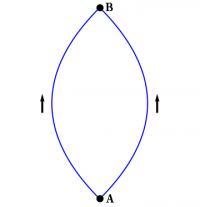You are here: start » book » mathcontent » path
RECALL: $\qquad\displaystyle\Int_a^b{df\over dx}\,dx = f \Big|_a^b$
This is the Fundamental Theorem of Calculus, which just says that the integral of a derivative is the function you started with. We could also write this simply as $$\int df = f$$ But recall the master formula (2) of § {Gradient}, which says $$df = \grad{f} \cdot d\rr$$ Putting this all together, we get the fundamental theorem for line integrals, which says that $$\Lint \grad{f} \cdot d\rr = f \Big|_A^B$$ for any curve $C$ starting at some point $A$ and ending at some point $B$. This situation is illustrated in Figure 1.
Notice that the right-hand side does not depend on the curve $C$! 1) This behavior leads us directly to the notion of path independence. A line integral of the form $\DS\Lint\FF\cdot d\rr$ is said to be independent of path if its value depends only on the endpoints $A$ and $B$ of the curve $C$, not on the particular curve connecting them. If a line integral is independent of path, we no longer need to specify the path $C$, so we instead write $$\Int_A^B \FF \cdot d\rr$$ If you know that a line integral is independent of path, you may choose a different path (with the same endpoints) which makes evaluating the integral as simple as possible!
